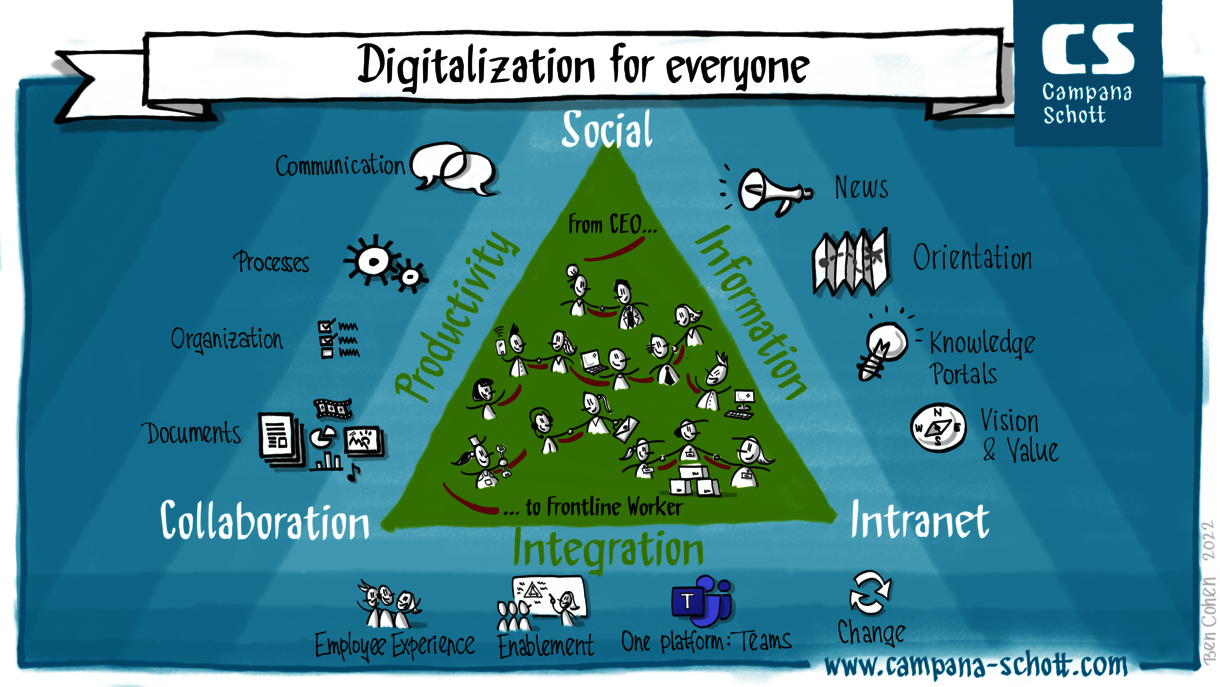Many companies have introduced digital workplaces – but only for information workers. Frontline workers often feel neglected by comparison, cut off from information, communication, or processes. This causes companies to suffer disadvantages such as loss of productivity due to having to switch media, dissatisfied staffers, and a risk of high turnover rates, along with low added value of the digital workplace. Suitable measures and practical employee apps can be used to get frontline workers digitally involved. Still, there are a number of things to bear in mind.
Completing the digital transformation – get frontline workers involved
Anyone who had a desk job before the pandemic can work from anywhere in the world these days. But those who work in a warehouse or on the production floor or have direct customer contact still have to walk all the way across the plant to take a look at the cafeteria menu or bulletin board. In many cases, frontline workers still submit their vacation requests on paper, and when they need to swap shifts, they talk to others in person or via WhatsApp. However, WhatsApp is a tool for private individuals. It does not offer features suitable for enterprise use, and security is not high.
Companies should introduce secure digital applications and workplaces for frontline workers as well with the goal of protecting internal company information and creating a shared digital workplace for all employees. But how should they do that in practice? Experience gleaned from many projects has shown that a process involving the steps discussed below can be useful, as this article (in German) shows.
Getting to the root of the issue
Instead of putting out individual fires, it is a good idea to take a step back so we can see the big picture as we think about frontline workers and then decide how to respond. Roles and the associated needs should be identified as part of this process, with priorities being set according to potential impacts. After that, the potential solutions for digitalization in various areas should be worked out (see Fig. 1).
Companies should start out with small, manageable digitalization scenarios: the low-hanging fruit, as it were. In principle, people’s fundamental needs for communication, cooperation, and organization are very similar across industries and roles. This makes it possible to get started right away with minor risk, for example by rolling out company news for all employees. This project can then be expanded in stages until all work processes have been digitalized (see Fig. 2).
What kind of technical basis will work?
Companies should look at factors such as how well a solution is crafted for the future and its scalability right from the start. After all, one thing is clear: quick one-offs and individual products do not stand the test of time, since requirements change, further advances are made, and each independent app increases the time, effort, and cost associated with managing it. This means the situation calls for easy-to-use, wraparound corporate solutions that meet security and compliance specifications. There are a few points to consider in this context:
- Device strategy: Companies need to decide which devices frontline workers should be able to use to access relevant information and applications. There are three possibilities: shared devices belonging to the company, including kiosk PCs; devices owned by the company but available for personal use; and personal devices owned by employees themselves (bring your own device, or BYOD).
- Security and identity: Frontline workers often do not have personalized access information of their own within the company, instead using shared accounts to access applications and information. However, a modern workplace concept requires that personalized login information be provided for frontline workers, just like others.
- Compliance and works council: It is necessary to clarify from a compliance standpoint how data and information can be shared securely with frontline workers, or what aspects need to be considered in case of decentralized creation and administration of identities. Scenarios such as use of personal devices to access company data or creation of new identities definitely need to be coordinated with the works council.
For more information on the technical bases used to integrate frontline workers digitally and concrete best practices, see this article (in German).
Why is digitalization necessary?
Now the right use cases should be selected on a top-down basis with a holistic view of the situation of frontline workers. To do this, it is helpful to hold interactive workshops to map out the existing situation, the roles of frontline workers and their environment, pain points, and needs. This is followed by a deep dive on WHERE and WHY these scenarios arise. This can be identified based on four points, which will come up again later when considering the use cases:
- Communication
- Information
- Cooperation
- Organization (including self-organization)
Who needs to be involved?
The next question is WHO: Which frontline workers does this concern, and which roles that interact with them need to be considered? HR and IT should be involved in this stage early on, if necessary, along with the specific departments themselves. During this phase, it is important to clarify which specific disruptive factors and obstacles exist, what technical equipment is on hand, and which routines typically cause dissatisfaction.
What is the solution?
After that, it is necessary to analyze WHAT. Ideally, an experienced external partner collaborates with key representatives from all the relevant areas of the company to identify the use cases, bringing together communication, information, cooperation, and organization (including self-organization). Classic use cases include coordination between people, within a team, in a group, or within the line (communication), company news (information), shift scheduling, continuing education or vacation requests (organization), along with complex procedures within a production process or project (cooperation).
- Check out this article (in German) for a look at how to craft fast, targeted digital communications for frontline workers. It particularly addresses communication within processes, pointing to concrete examples: sending messages to specific user groups, action plan communications in case of accidents, production information for all concerned, and cross-location solutions to problems.
- This article (in German) explains how to make it easy for production to shift to new components or different suppliers. Instead of extensive approval processes, modern apps allow the specialists responsible and frontline workers to give approval quickly, so production stays up and running.
- This article (in Geman) describes how frontline workers can use Microsoft Teams to make efficient, long-term arrangements for transportation, hotel bookings, meetings, and bringing small parts along to construction sites. Apps can show driving or transit directions, which contact people will be there, safety rules, and necessary training sessions at a glance.
How can this be put into action?
One crucial point is that everyone involved needs to be met where they are, right from the start. HOW is the crucial factor here. Adoption and change management for frontline workers involves completely different challenges, areas of resistance, working methods, and digitalization levels than is the case with information workers.
Different measures are advisable depending on the company’s maturity level. Still, it is always necessary to choose a style and means of communication geared toward benefits, showing employees from their own perspective how the new technology can help them concretely. Beyond that, the staff should be given the opportunity to participate in workshops, interviews, or work shadowing, thereby actively becoming part of the change themselves.
To Teams or not to Teams?
Microsoft 365 is generally a good platform for the apps, as it is already in use among the information workers at the company – and in many frontline jobs as well. Standard tools such as Teams, SharePoint, and Yammer can already support many use cases. This means companies don’t have to reinvent the wheel. Instead, they can use a proven platform to create a quality employee experience.
Microsoft Teams offers many features for this. True, not all features are needed for all use cases, but when making their decisions, companies should be sure to consider that as digitalization advances, new use scenarios are constantly being added for frontline workers as well, and requirements are growing ever more stringent. Instead of individual solutions, Microsoft Teams offers a standardized platform that can cover a full range of use cases now and into the future.
When making their strategic choices, companies should also take the platform’s flexibility, ability to adapt to future needs and challenges, scalability, and expandability into account. A bit more change management is needed with Teams, but the time, effort, and expense involved in IT management don’t simply expand immeasurably, as would be the case with an ever-increasing range of individual solutions. All this makes Teams the ideal platform for the digital transformation, for information workers and frontline workers alike.
Conclusion
Incorporating frontline workers into the digital world should be viewed holistically. Companies should select low-hanging fruit for pilot projects, introduce suitable technology, roll out efficient processes, and support these actions with targeted adoption measures. Doing so allows all employees to benefit from digitalization.
Author
Weiterführende Inhalte
Frontline Worker
Digital Workplace
Microsoft Teams




